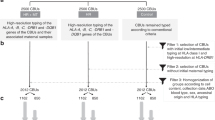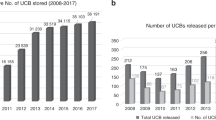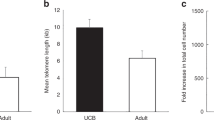Abstract
Methods for estimating the cord blood (CB) inventory size required vary according to the ethnic diversity of the HLA, degree of HLA matching and HLA-typing resolution. We estimated the CB inventory size required using 7190 stored CB units (CBU) and 2450 patients who were awaiting or underwent allogeneic hematopoietic stem cell transplantation. With high-resolution typing of HLA-A, B and DRB1, 94.6% of Korean patients could find CBUs in 100 000 CBUs with a 5/6 match, and 95.7% could find CBUs in 5000 CBUs with a 4/6 match. With low-resolution typing of HLA-A and B and high-resolution typing of leukocyte antigen-DRB1, 95% of patients could find CBUs in 50 000 CBUs with a 5/6 match, and 96.7% could find CBUs in 3000 CBUs with a 4/6 match. With additional high-resolution typing for HLA-A and B, which could improve transplantation outcome, the size of the CB inventory would need to increase twofold for Koreans.
This is a preview of subscription content, access via your institution
Access options
Subscribe to this journal
Receive 12 print issues and online access
$259.00 per year
only $21.58 per issue
Buy this article
- Purchase on Springer Link
- Instant access to full article PDF
Prices may be subject to local taxes which are calculated during checkout


Similar content being viewed by others
References
Rubinstein P . Why cord blood? Hum Immunol 2006; 67: 398–404.
Eapen M, Rubinstein P, Zhang MJ, Stevens C, Kurtzberg J, Scaradavou A et al. Outcomes of transplantation of unrelated donor umbilical cord blood and bone marrow in children with acute leukaemia: a comparison study. Lancet 2007; 369: 1947–1954.
Completion of the review-and-evaluation on cord blood banks. 2012. Public announcement from Ministry for Health and Welfare of Korea; available at (www.129.go.kr; accessed on, 5 Feb 2014).
Lee YH, Kwon YH, Hwang K, Jun H, Lee MA, Jang HI et al. Analysis of stored and transplanted cord blood units from KoreaCORD: reappraisal of banking guidelines and selection strategy. Transfusion 2012; 53: 123–127.
Kurtzberg J, Cairo MS, Fraser JK, Baxter-Lowe L, Cohen G, Carter SL et al. Results of the cord blood transplantation (COBLT) study unrelated donor banking program. Transfusion 2005; 45: 842–855.
Beatty PG, Mori M, Milford E . Impact of racial genetic polymorphism on the probability of finding an HLA-matched donor. Transplantation 1995; 60: 778–783.
Ponce DM, Gonzales A, Lubin M, Castro-Malaspina H, Giralt S, Goldberg JD et al. Graft-versus-host disease after double-unit cord blood transplantation has unique features and an association with engrafting unit-to-recipient HLA match. Biol Blood Marrow Transplant 2013; 19: 904–911.
Santamaria P, Lindstrom AL, Boyce-Jacino MT, Myster SH, Barbosa JJ, Faras AJ et al. HLA class I sequence-based typing. Hum Immunol 1993; 37: 39–50.
Kotsch K, Wehling J, Blasczyk R . Sequencing of HLA class II genes based on the conserved diversity of the non-coding regions: sequencing based typing of HLA-DRB genes. Tissue Antigens 1999; 53: 486–497.
Pozzi S, Longo A, Ferrara GB . HLA-B locus sequence-based typing. Tissue Antigens 1999; 53: 275–281.
Yoon JH, Oh S, Shin S, Park JS, Roh EY, Song EY et al. The minimum number of cord blood units needed for Koreans is 51 000. Transfusion 2013; 54: 504–508.
Querol S, Mufti GJ, Marsh SG, Pagliuca A, Little AM, Shaw BE et al. Cord blood stem cells for hematopoietic stem cell transplantation in the UK: how big should the bank be? Haematologica 2009; 94: 536–541.
Takanashi M, Tanaka H, Kohsaki M, Nakajima K, Tadokoro K, Nakabayashi M . A suggested total size for the cord blood banks of Japan. Bone Marrow Transplant 2011; 46: 1014–1015.
Lee KW, Oh DH, Lee C, Yang SY . Allelic and haplotypic diversity of HLA-A, -B, -C, -DRB1, and -DQB1 genes in the Korean population. Tissue Antigens 2005; 65: 437–447.
Kawase T, Morishima Y, Matsuo K, Kashiwase K, Inoko H, Saji H et al. High-risk HLA allele mismatch combinations responsible for severe acute graft-versus-host disease and implication for its molecular mechanism. Blood 2007; 110: 2235–2241.
Morishima Y, Kawase T, Malkki M, Petersdorf EW . Effect of HLA-A2 allele disparity on clinical outcome in hematopoietic cell transplantation from unrelated donors. Tissue Antigens 2007; 69 (Suppl 1) 31–35.
Kurtzberg J, Prasad VK, Carter SL, Wagner JE, Baxter-Lowe LA, Wall D et al. Results of the Cord Blood Transplantation Study (COBLT): clinical outcomes of unrelated donor umbilical cord blood transplantation in pediatric patients with hematologic malignancies. Blood 2008; 112: 4318–4327.
Eapen M, Klein JP, Ruggeri A, Spellman S, Lee SJ, Anasetti C et al. Impact of allele-level HLA matching on outcomes after myeloablative single unit umbilical cord blood transplantation for hematologic malignancy. Blood 2014; 123: 133–140.
Eapen M, Klein JP, Sanz GF, Spellman S, Ruggeri A, Anasetti C et al. Effect of donor-recipient HLA matching at HLA A, B, C, and DRB1 on outcomes after umbilical-cord blood transplantation for leukaemia and myelodysplastic syndrome: a retrospective analysis. Lancet Oncol 2011; 12: 1214–1221.
Kanda J, Atsuta Y, Wake A, Ichinohe T, Takanashi M, Morishima Y et al. Impact of the direction of HLA mismatch on transplantation outcomes in single unrelated cord blood transplantation. Biol Blood Marrow Transplant 2013; 19: 247–254.
Acknowledgements
EYS and JYH contributed to drafting of the article; SO designed and performed statistical analysis; EYR contributed to acquisition of CB data; JHY contributed to the analysis of patients' HLA data; MHP was the intellectual advisor of HLA allelic distribution and data analysis; MSK and SS contributed to overall conception and designing the study.
Author information
Authors and Affiliations
Corresponding authors
Ethics declarations
Competing interests
The authors declare no conflict of interest.
Additional information
Supplementary Information accompanies this paper on Bone Marrow Transplantation website
Supplementary information
Rights and permissions
About this article
Cite this article
Song, E., Huh, J., Kim, S. et al. Estimation of size of cord blood inventory based on high-resolution typing of HLAs. Bone Marrow Transplant 49, 977–979 (2014). https://doi.org/10.1038/bmt.2014.76
Received:
Revised:
Accepted:
Published:
Issue Date:
DOI: https://doi.org/10.1038/bmt.2014.76



